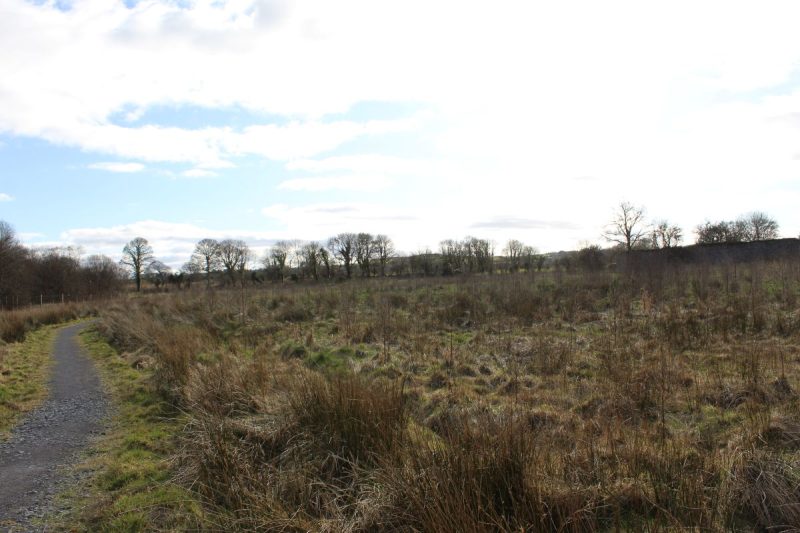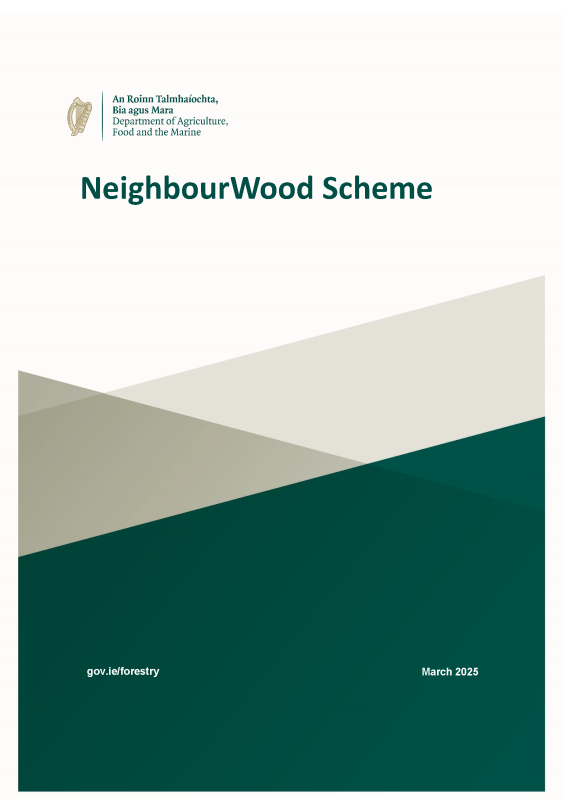The NeighbourWood Scheme aims to increase the suitability of Ireland’s woodlands and forests for recreational use, by supporting the silvicultural enhancement of existing woodlands and forests and the introduction of appropriate recreational facilities. The Minister for Agriculture, Food and the Marine, Martin Heydon, TD, and the Minister of State with responsibility for Forestry, Farm Safety and Horticulture, Michael Healy-Rae, TD, launched the NeighbourWood Scheme on March 13th 2025. The scheme is open for new applications under the Forestry Programme 2023-2027. This Scheme provides a range of options to support private and public forest owners considering developing their forest into attractive, easily-accessible local woodlands for the recreational use and enjoyment by communities in both urban and rural parts of Ireland. Such woodlands have been shown to deliver significant social and environmental benefits, promote physical and mental health and wellbeing amongst visitors, and represent a valuable resource within the surrounding locality.
Extract
“The overall objective of the NeighbourWood Scheme is to develop attractive, easily-accessible local woodlands for the recreational use and enjoyment by communities in both urban and rural parts of Ireland. Such woodlands will cater for a range of recreational uses and pursuits, but ultimately, will create opportunities for people to experience the natural world, to take exercise, and to enjoy the company of family and friends in a relaxed natural setting, all of which have been shown to increase mental and physical health and wellbeing and to contribute to a better quality of life. The NeighbourWood Scheme provides support for (i) silvicultural works designed to enhance existing forests and to increase their functionality and attractiveness for recreation; and (ii) the installation of suitable recreational facilities, including familiar features such as trails, seats, signs and parking to cater for all users, to more specialised facilities to cater for particular user groups, such as hides for birdwatching. The Scheme can be applied for in relation to a wide range of recreational forest types, e.g. close to-home ‘neighbourwoods’ used by local people on a daily basis. The Scheme can also be used to strengthen the role of a forest as a focus for outdoor fitness training or forest classroom educational programmes, or as a setting for an important heritage or cultural feature, or as part of a wider amenity development /network, such as ‘green ways’ or National Waymarked Trails. This Scheme is aimed primarily at publicly-owned woodlands, but woodlands under community ownership or management trusts are eligible, as are private forests. However, certain criteria must be met in all cases, for a project to be eligible under this Scheme. Specifically, all applications must demonstrate a recreational need, clear user group(s), the accessibility and suitability of the forest for recreational development, and a partnership between the owner and the user(s) in developing the application and implementing the project (if approved).”
Applicants can apply under one or both elements of the Scheme, which are described as follows:
Element 1: Enhancement
- This element provides support for silvicultural works designed to enhance existing forests and to increase their attractiveness, biodiversity and suitability for recreation. Potential operations include the removal of invasive species, coupe planting to re invigorate stagnant canopies, and the replacement of existing conifer stands with native woodland.
Under Element 1, projects can receive up to €6,000 / ha in funding, based on approved costs and subject to an upper limit of €72,000 (i.e. €6,000 x 12 ha).
Element 2: Facilities
This element provides funding for the installation of suitable recreational facilities that enable the use and enjoyment of existing woodlands and forests by people. These facilities can range from general features such as trails, seats, signs and parking to cater for the general user, to more specialised facilities for particular user groups.
Under Element 2, projects can receive up to €4,200 / ha, based on approved works and subject to an upper limit of €50,400 (i.e. €4,200 x 12 ha). It is aimed at existing woodlands, including woodlands that have been recently planted.
Applicants may wish to pursue applications under the Native Woodland Conservation Scheme or reforestation options under the Climate Resilient Reforestation Scheme to undertake silvicultural operations, alongside an application under Element 2 of the NeighbourWood Scheme, to develop appropriate facilities within the woodland.
Publications and Resources:
- The publication “Management Guidelines for Ireland’s Native Woodlands” (2017), produced jointly by DAFM and the National Parks & Wildlife Service, will provide useful information on management practices that will be directly applicable to many NeighbourWood Scheme projects, particularly those with a native woodland ‘slant’. It also contains information in relation to woodland ecology, which can inform any text used to promote the NeighbourWood Scheme project, including onsite interpretative boards.
- DAFM’s “Forestry Recreation in Ireland: A Guide for Forest Owners and Managers” (2006) provides direction on assessing and realising the recreational potential of individual forests. These guidelines deal with issues such as consultation with recreational users, access for all, recreational facilities, safety, environmental education, and integration with local trails, tourist enterprises and heritage attractions.
- For information on recreational trail development, see “A Guide to Planning and Developing Recreational Trails in Ireland” and “Management Standards for Recreational Trails“, both published by Sport Ireland Outdoors.
- The publication entitled “Amenity Trees and Woodlands: A Management Guide to their Management in Ireland” (2010) provides useful guidance and references, particularly in relation to its chapters on amenity woodlands and local participation. This publication was published by the Tree Council of Ireland, the Arboricultural Association (Irish Branch) and the Society of Irish Foresters.
- The Department has worked closely with the Climate Action Regional Offices (CARO) in relation to that organisation’s efforts to promote woodland creation among Local Authorities. Although aimed specifically at Local Authorities and opportunities for native woodland creation under the Afforestation Scheme, the FAQ resource developed by CARO will be highly relevant to the NeighbourWood Scheme.
Important Documents:
Applications may now be submitted by Registered Foresters for the NeighbourWood Scheme. The application process involves the development of a NeighbourWood Plan, following a prescribed template. Any queries should be directed to Approvals.ForestService@agriculture.gov.ie

- Full details of the Scheme are available for download at: NeighbourWood Scheme
- The NeighbourWood Plan template (and guidance therein) is designed not only to gather information DAFM needs to assess the proposed project, but also to direct the applicant and partners through various decisions that need to be made in relation to forest development. Also note Annex 2 of this Scheme document, included to assist in the completion of the plan.
Application Process
The application process under the NeighbourWood Scheme requires the input of a Registered Forester. This individual will have an in-depth knowledge of the Department’s forestry schemes and associated terms and conditions, including those relating to the protection of the environment. Check the list of registered foresters where you can locate a qualified forester in your area. If approved, they must also be involved in the implementation of the project and the submission of the application for grant payment. Many Registered Foresters will also have direct experience of working with earlier iterations of the NeighbourWood Scheme. Numerous projects have been completed throughout Ireland under previous iterations of this Scheme. As such, there is a wealth for learning to be gained by contacting the parties involved. Contact the Department (at Forest.Environment@agriculture.gov.ie), should you wish to get in touch with key parties involved in implementing related projects. (Please include ‘NeighbourWood Scheme query’ in the e-mail title, and state your county.)
Native Woodland Conservation Scheme Training
Native Woodland Training Courses are held periodically by the Forest Service of DAFM in association with Woodlands of Ireland for landowners, stakeholders (i.e. statutory agency staff, nursery owners, environmental NGOs and interested individuals) and Native Woodland Conservation Scheme (NWC) practitioners (i.e. foresters, ecologists and woodland contractors). Training can entail 2-day courses that encompass a broad range of management, ecological and silvicultural topics specific to Native Woodland Conservation. The 2-day course is also a requirement for NWC foresters and ecologists to attend in order to receive accreditation to work on the NWC contracts. Please see an updated directory of registered DAFM approved Foresters and Ecologists, note the foresters that are eligible to work on NWC contracts have a box ticked on the available registered list from DAFM. (Woodlands of Ireland will endeavor to keep these list links updated) Please see Native Woodland Information Notes as supporting literature to the NWC.
If you would like to be added to the waiting list for upcoming NWC training courses, please email info@woodlandsofireland.com with your name, location and contact number.
